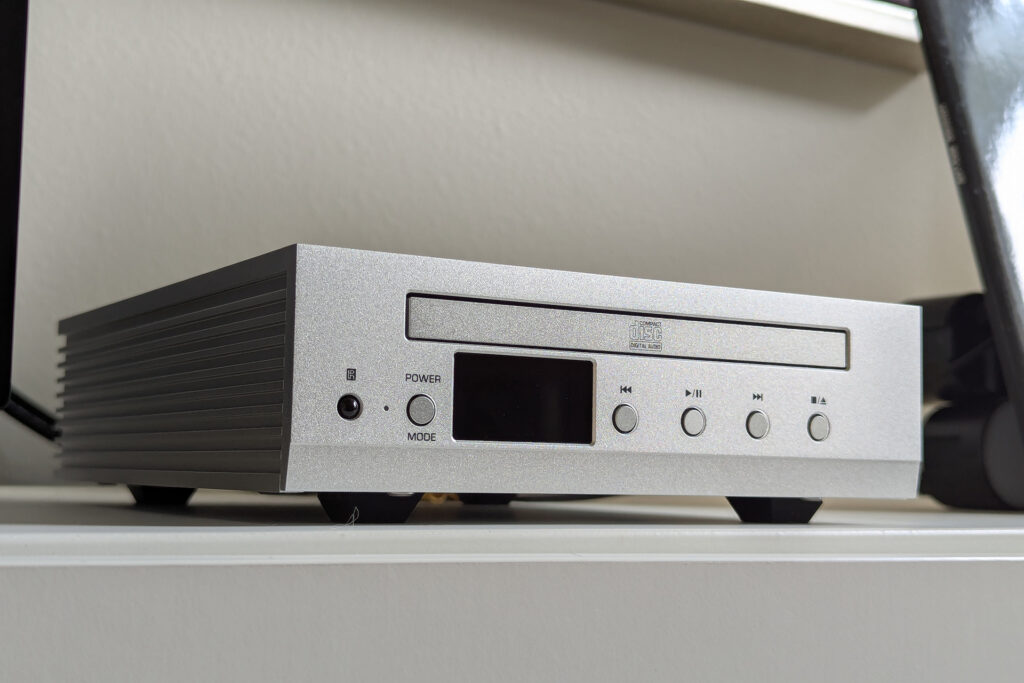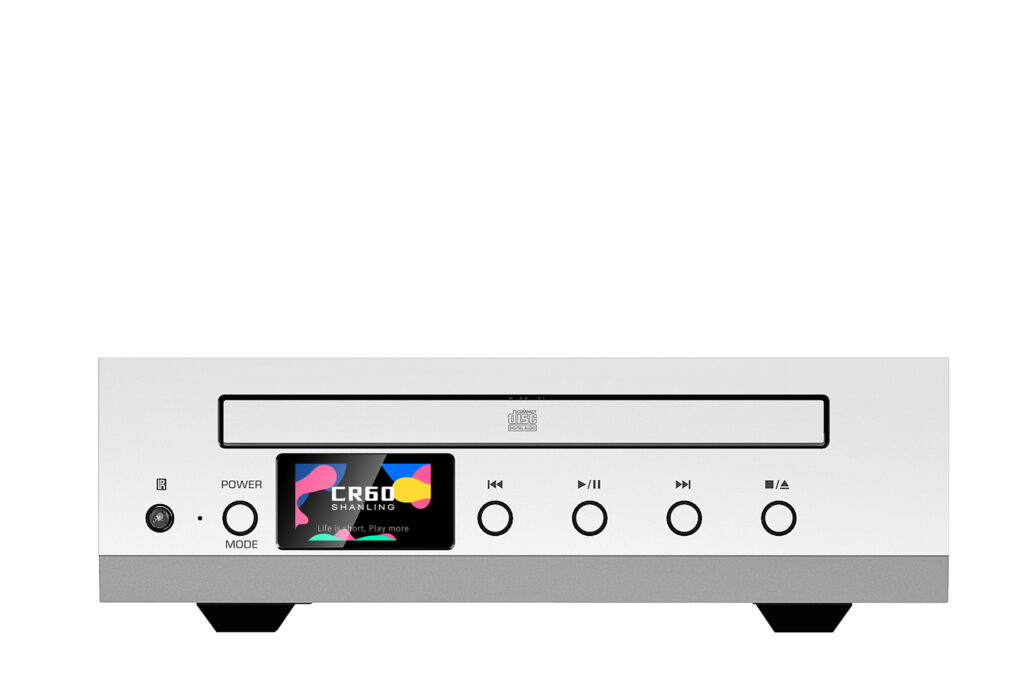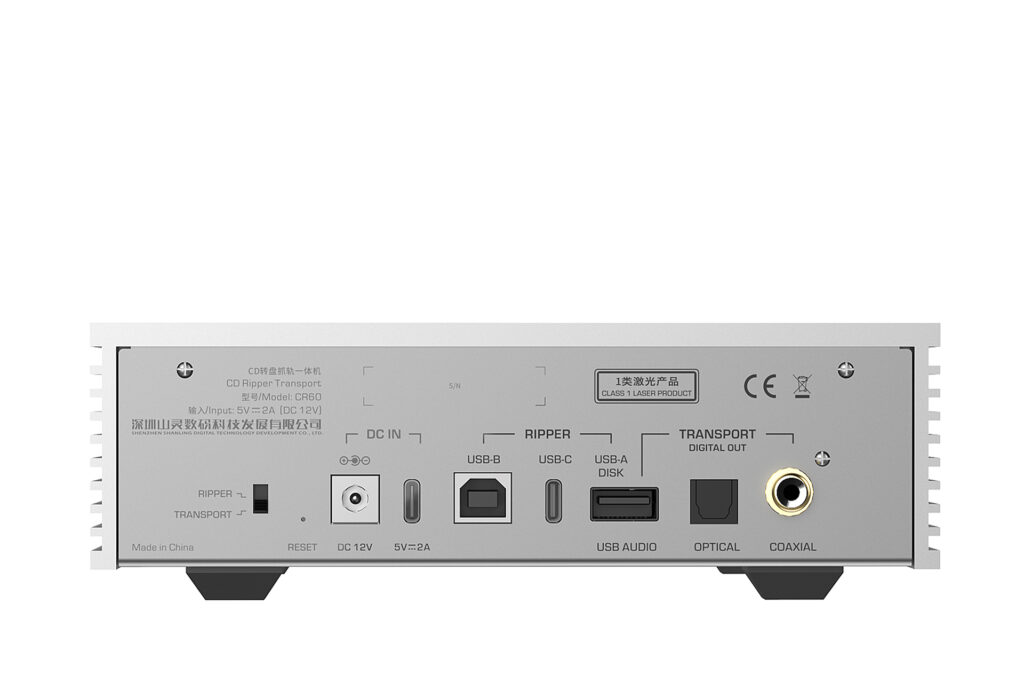One of the more challenging questions for many audiophiles who own a physical media collection is how to both play your Compact Discs and get them ripped to your network server or wherever you like to keep your music files. Apple still sells an Optical Disc drive. but this under-$100 component isn’t very audiophile, nor is it very suitable for playing back CDs at the level that an audio enthusiast likely would expect. Compact Discs are close to free on the used market and a ripped AIFF file sounds really pretty good. Hell, most local libraries lend out Compact Discs. Your friends might give you their CDs, with streaming being so mainstream today. And good SSD (solid state drive) storage is dirt cheap. A friend of mine just got a deck-of-cards-sized Samsung USB-C four-terabyte drive for just over $300. It is a brave new world for those of us who still want to both spin and rip our silver discs.
The Shanling CR60 CD Transport and Ripper, priced at $299, offers a very good deal by delivering both professional-grade CD transport capabilities and comprehensive ripping functionality in a single well-executed audiophile component. Built around a respected Philips drive mechanism with Sanyo HD850 laser assembly, the Shanling CR60 provides the transport quality serious listeners demand, while adding modern digitization features that acknowledge how people actually use their music collections. For collectors looking to bridge physical and digital libraries without compromise, this might be the most practical CD-related purchase available today.

What Makes the Shanling CR60 CD Transport and Ripper Special?
- The dual-mode design seamlessly transitions between transport and ripper functionality through a simple rear-panel switch. Unlike computer-based solutions that compromise on transport quality or dedicated transports that ignore digitization needs, the Shanling CR60 excels at both missions. The foundation starts with serious components: a Philips CD drive mechanism paired with Sanyo’s HD850 laser assembly, the same combination found in players costing significantly more.
- The technical implementation reveals Shanling’s audiophile priorities with the Ingenic X1000 processor and Xburst CPU architecture handling digital signal processing without introducing the typical computer-based noise and jitter issues. More importantly, the Shanling CR60 functions as a pure digital transport with no built-in DAC, preserving maximum flexibility for system matching, while keeping costs focused on transport quality rather than potentially inferior conversion stages.
- Connectivity options demonstrate modern thinking without gimmickry. Standard coaxial and optical SPDIF outputs handle traditional DAC connections, but the USB-A digital audio output represents genuine innovation – directly connecting to popular USB dongle DACs without requiring USB-to-SPDIF converters. This acknowledges how many audiophiles actually build systems today, using compact high-performance USB DACs rather than traditional full-size components. Yes, USB brings power (think noise, distortion, etc.), but its convenience and relevance is hard to argue with.
- The ripping functionality of the Shanling CR60 impresses through its comprehensiveness.Direct USB drive ripping produces uncompressed WAV files with automatic organization, while the companion Eddict Player app enables FLAC compression and metadata management when ripping to Android devices. The system creates logical folder structures automatically and handles album art retrieval, approaching the sophistication of dedicated music server solutions at a fraction of the cost.
- The build quality of the Shanling CR60 exceeds expectations for the $299 price point. The aluminum alloy chassis weighs a substantial 1.7 kilograms, despite its compact 200 by 180 by 50 millimeter dimensions, providing the stability serious transports require. The 1.14-inch color LCD display offers clear operational feedback without the complexity that increases failure rates in competing products.

Why Should You Care About the Shanling CR60 CD Transport and Ripper?
The Shanling CR60 addresses a fundamental inconvenience facing every serious music collector: how to maintain access to your physical media investment while embracing digital convenience. Traditional solutions force compromise – computer ripping sacrifices transport quality, while audiophile transports ignore digitization entirely. The CR60 eliminates this false choice by delivering both capabilities without meaningful compromises in either.
For collectors with extensive Compact Disc libraries, the math becomes compelling quickly. Professional digitization services cost $2 to $5 dollars per disc, making the Shanling CR60 cost-effective after processing just 75 to 150 albums. More importantly, you maintain control over format choices, quality settings, and can re-rip problematic discs as needed, rather than accepting whatever quality a service provides. The unique USB-A digital output creates new system-building possibilities that competing products simply don’t offer, connecting directly to popular USB DACs from companies like Topping, S.M.S.L. and Cambridge Audio without additional converters.
Some Things You Might Not Like About the Shanling CR60 CD Transport and Ripper
- The Samsung Android compatibility issue represents a significant limitation that Shanling should have disclosed more aggressively. Users with Samsung phones and tablets cannot utilize the direct ripping functionality – a problem affecting a substantial portion of the Android market. While alternative ripping methods exist, this limitation contradicts the product’s promise of universal smartphone integration.
- Documentation quality falls short of the hardware’s sophistication. The included materials barely explain the various ripping modes and don’t adequately address device compatibility issues. Users must rely on online resources and community knowledge to unlock the CR60’s full functionality – frustrating for a product targeting less technical users.

Using the Shanling CR60 CD Transport and Ripper …
The Shanling CR60’s operation reveals thoughtful design that prioritizes functionality over flashy features. The compact chassis sits naturally on a desktop or shelf, with the 1.14-inch color LCD providing clear operational feedback that’s readable from arm’s length, but becomes challenging from typical listening distances. Physical controls are limited to essential function – power, play/pause, skip, and eject – keeping the interface clean and reliable.
Switching between transport and ripper modes requires a simple toggle on the rear panel, but this physical switch means you need rear access each time you change functions. This design choice prioritizes signal path integrity over convenience, which aligns with audiophile priorities, but may frustrate users who frequently alternate between modes. The unit remembers your last operational state, so purely transport users can set it once and forget about the switch entirely
As a pure digital transport, the Shanling CR60 maintains strict neutrality that becomes apparent through extended use. Connected to various audiophile DACs ranging from budget Topping units to higher-end Cambridge Audio models, the CR60 consistently delivers the digital bitstream without editorial comment. This characteristic becomes most obvious when comparing transport outputs – the coaxial SPDIF maintains traditional compatibility with older DACs, while the USB-A output often provides superior performance with modern asynchronous USB DACs by allowing the DAC to handle clocking responsibilities. The transport doesn’t impose any particular sonic signature, which means your DAC choice becomes the primary determinant of system character.
The ripping process proves surprisingly intuitive once you understand the workflow. With a USB drive connected and the rear switch in rip mode, inserting a CD automatically begins the extraction process. The LCD displays track progress and basic metadata when available, though you’ll want to verify album information through the companion Eddict Player app for Android devices. Ripping a typical 60-minute album takes approximately eight to 12 minutes, creating uncompressed WAV files with logical folder structures that most music management software recognizes immediately.
Working with the Eddict Player app reveals both the system’s capabilities and its limitations.When the app connects successfully (remember the Samsung compatibility issue), it provides comprehensive metadata editing, album art retrieval, and FLAC compression options that the standalone unit cannot offer. The interface feels modern and responsive, making the digitization process almost enjoyable rather than the tedious chore that computer-based ripping often becomes.
Daily operation settles into predictable patterns that highlight the Shanling CR60’s strengths.Transport users appreciate the reliable disc loading, quiet operation, and consistent digital output that makes the unit effectively invisible in the signal chain. Ripping enthusiasts develop efficient workflows around batch-processing multiple albums, taking advantage of the automatic folder creation and consistent file naming that eliminates post-processing cleanup. The device handles both roles competently without the compromises that typically define dual-purpose audio equipment.
Will the Shanling CR60 CD Transport and Ripper Hold Its Value?
Market dynamics favor products like the Shanling CR60 as streaming services continue removing content and new Compact Disc releases become increasingly expensive. The ability to digitize collections becomes more valuable over time rather than less, creating sustained demand for capable ripping solutions among serious collectors.
However, technological evolution poses risks to long-term value retention if major DAC manufacturers abandon USB input standards or new digital formats emerge. At $299, most audiophiles will use a component like the Shanling CD60 for what it is until it dies and then put it into the recycling bin and move on, and that seems pretty fair.

What is the Competition for the Shanling CR60 CD Transport and Ripper?
The Cambridge Audio CXC v2 ($599 Buy at Crutchfield) represents the primary transport competition, despite lacking ripping capabilities. The Cambridge Audio CXC v2’s award-winning S3 servo transport mechanism and premium build quality justify its price for users prioritizing absolute transport performance over functionality. However, the CR60 delivers approximately 85 percent of the CXC’s transport quality, while adding comprehensive ripping capabilities for half the price – a value proposition the Cambridge cannot match.
The Audiolab 6000CDT ($799 buy at Crutchfield) offers competition but still costs a lot more than the CR60, while providing only transport functionality. The Audiolab’s slot-loading mechanism and read-ahead buffering provide advantages in handling damaged discs, but most users will find the Shanling CR60’s tray-loading design more reliable long-term, while appreciating the significant cost savings and added ripping functionality.
The Naim Audio Uniti Star ($5,699 by at Crutchfield) represents the premium all-in-one approach to CD transport and ripping functionality. The Uniti Star includes the same core CD transport and ripping capabilities as the Shanling CR60, but adds integrated amplification, streaming services, DAC, and network connectivity in a single chassis. While the additional functionality justifies the premium, the over 500 percent price increase over the CR60 shows the value proposition that Shanling has achieved. The Naim certainly offers superior build quality, premium materials, and the convenience of integrated amplification, but users who already own quality separates will find the CR60 delivers the essential CD functionality at a fraction of the cost, while maintaining system flexibility.
Final Thoughts on the Shanling CR60 CD Transport and Ripper …
The Shanling CR60 succeeds brilliantly at solving a common inconvenience that affects every serious CD collector: how to maintain high-quality playback while efficiently digitizing collections for modern convenience. At $299, it delivers performance and functionality that competing approaches simply cannot match without significant compromises or much higher costs.
Compatibility issues and documentation shortcomings prevent the Shanling CR60 from achieving perfection, but these limitations feel minor compared to the overall value proposition for most users. For audiophiles with substantial Compact Disc collections, the Shanling CR60 becomes nearly essential, providing a practical path to preserve physical media investments while embracing digital convenience. The quality level exceeds what most users expect at this price point, while the functionality eliminates the need for separate transport and ripping solutions that collectively cost significantly more.




Seems like a solution looking for a problem with significant caveats. I use Asunder with Ubuntu on an HP ProDesk desktop PC, it works great & has professional level disc reading capability. There are similar apps for Win & Mac.
I love everything about this. I have an Apple optical drive connected to a Linux machine that I use as a streaming server, but trying to get the ripping function has been like pulling teeth. I had an Eversolo DMP A6 G2 that streamlined this process and I loved it! Until the super sweet linear power supply fried at four months old. My biggest concern with this device would be the same as with the Eversolo. Good service support is very difficult for these ChiFi companies int he US. I had an SMSL PL100 that I also loved, but it too died. Fortunately I had bought it through Apos, who were amazing about the return. The DMP A6 was from Audio Advice and it was an absolute nightmare. I still suffer PTSD from the exchange with Audio Advice management.